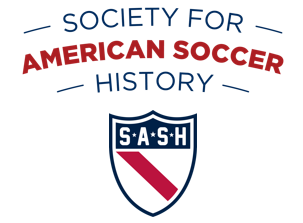A few years ago, I saw a Tweet from Mark Metcalf about his work to identify the player who scored the first English Football League goal in 1888. Who had the honor of netting the first goal in an openly professional league in soccer history? It was Kenny Davenport scoring for Bolton Wanderers at 3:47 pm on September 8, 1888 against Derby County. By 1894 the US had its own openly professional leagues, and I wondered who scored the first goal in these competitions? While I was at it, I also sought to answer the same question for the American Soccer League (ASL) that started in 1921.
The American Association of Professional Football (AAPF) clubs played its opening two games on September 29, 1894. One of these matches took place in Newark, New Jersey, between the Kearny Unions (representing Newark) and the Paterson Association Football Club. Unfortunately, we do not know the time the match started, and while we have a list of scorers, there is no indication of when the goals went into the net. Until we have more information, we have to look to the other game to answer our question. The second match of the day was played at the Tioga Athletic Grounds in Philadelphia and featured the home side versus Trenton. Philadelphia won the match 11-1 and reports indicate that Trenton scored its lone goal after Philly had already notched all of theirs.
Two different newspapers list Philly’s scorers but in different orders. If we accept the list given in the Philadelphia Inquirer then it would be David Wilson who scored the first professional goal. Little is known of Wilson, but he was born in Scotland, possibly Ayrshire around 1865. The Public Ledger however, had a connection with the home side, so perhaps that order was more likely to be accurate. If we believe that, then Charles Sudell Jr. began the scoring in the AAPF, making him the first openly professional goal scorer in US soccer history. Sudell was born on May 28, 1867 in Blackburn, England, and came to the US as a child in 1873. He lined up for several local sides and was selected in various all-city teams that faced off against select squads from New York and New Jersey. A slight man weighing just 145 pounds, Sudell was known for his speed and quick shot. His uncle, William Sudell, became secretary of English club Preston North End in 1874 or 1875. He quickly recruited Scottish professionals to reinforce the squad and built a formidable team. William worked to launch the Football League in 1888 and managed Preston’s “Invincibles” to the world’s first double – winning both the league and the Football Association Cup.
The American League of Professional Football (ALPF) clubs kicked off a week later on October 6, 1894. Once again there were two games on opening day. Boston against Brooklyn kicked off at 3:30 pm but the start time of the other match is unknown. At the South End Baseball grounds in Boston, Albert Jenkins of the home side scored a header in the first half. New York defeated Philadelphia 5-0 in the other match that day. One newspaper included this unusual listing of scorers with times.

I’m not exactly certain how to read the chart. It makes some sense if it is read from the bottom up. Two goals in the first half and three in the second. If that reading is correct the first goal scorer is William Lupton. Since we don’t know when the match kicked off or when Jenkins scored in the other match, we can’t be sure, but obviously a goal six minutes in is pretty early. It is possible though that the newspaper chart could be read in a different way. The goals could be listed in the order they were scored, with the minutes indicating the time remaining in the half, not the time elapsed as is usual today. If this is correct, that means that Connelly (the chart mistakenly lists him as Conley) scored the first goal for New York and not Lupton. Incidentally, we do not have a confirmed first name for this player, but an A T. Connelly played in a friendly against the New York team before the season started and possibly they liked what they saw and signed him to a contract. Another newspaper match report of the game however, indcates that Connelly’s goal came at the 40-minute mark of the first half. That time brings us back to Jenkins’s goal in the Brooklyn versus Boston game. Match reports seem to indicate that his goal came earlier in the half and likely before the 40-minute mark. That would make Albert Jenkins the first to score a goal in the ALPF. Jenkins was born in Smithfield, Rhode Island, on December 21, 1868. His parents immigrated to the US from Ireland and his brother Samuel also played for the Boston squad in the ALPF.
Finally, it is bit easier to identify the first goal scorer in the American Soccer League whose opening day was September 17, 1921. Once again, we have only two matches on the schedule, and both were 0-0 at halftime. In one match Dougie Campbell scored for Philadelphia against J&P Coats in minute 57. So that’s it then? Not so fast. In the other match, Ernest Logan scored for Holyoke Falcos against home side Fall River a few minutes after the second half kick-off. Both matches were scheduled to begin at 3 pm but the Falcos game actually kicked off a few minutes late. Was it delayed enough to mean that Campbell’s strike was the first ASL goal? We will probably never know for certain, but it seems more likely that Logan’s goal would still be first since it was described as coming only a few minutes after the restart.
Logan was born on Halloween 1894, just over a week after the death of the nation’s first professional leagues. His parents Samuel and Charlotte came from Ireland, but Ernest was born in Chicopee Falls, Massachusetts. A tall, slender man with blue eyes and light hair, Logan worked in a variety of industrial occupations including one with the curious title of “trouble investigator.” Eventually he relocated to Los Angeles, California, where he died in 1980. I might be biased as a resident of the Bay State, but I like the fact that the first ASL goal was likely scored by a Massachusetts-born player in Fall River. Seems fitting somehow.
Thanks to Dan Creel, @NYSoccerGiants, and Tom McCabe
